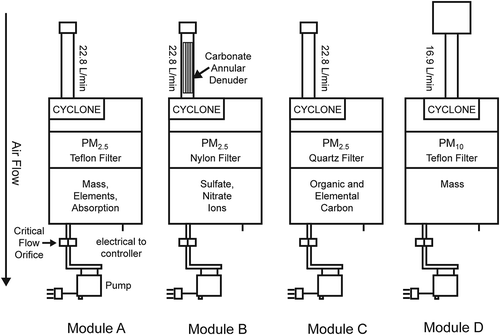Figures & data
Figure 1. CSN and IMPROVE site locations are illustrated as of (a) 2006 and (b) 2012. Colocated: sites where a network had side-by-side samplers to estimate precision. Carbon backup filter: IMPROVE sites (6 in 2006 and 12 in 2012) that had a QFF backup filter to estimate the OC artifact (see text for details). All CSN sites had backup QFF for OC artifact once the IMPROVE methods (URG 3000N sampler and IMPROVE_A analysis protocol) were implemented, between 2007 and 2009; prior to implementation of the URG 3000N no sites included backup QFF. An interactive IMPROVE map with a complete site list can be found at http://views.cira.colostate.edu/fed/Tools/SiteBrowser.aspx. CSN site listing can be found at EPA (Citation2013).

Table 1. Design specifications for IMPROVE and CSN samplers, the latter employed in EPA Speciation Trends Network
Table 2. Filter medium (as manufacturer and model), acceptance tests, and sample preparation
Table 3. Analytical procedures by filter type and component. All measured species are listed in
Table 4. Operating conditions for the original CSN and the current CSN and IMPROVE OC/EC analysis protocols
Table 5. Denuder characteristics by sampler type. Nylon channel in all samplers, see and
Table 6. Sampling handling, shipping conditions, holding times, and laboratory storage requirements.
Table 7. Filter characteristics, flow rates, and face velocities
Figure 2. CSN MetOne SASS sampler schematic. RAAS and MASS samplers were only used through early 2009; their schematics are available at Solomon et al. (Citation2000) and pictures, including SASS, are available at EPA (Citation2012c).

Figure 3. IMPROVE sampler schematic. Pictures are available at EPA (Citation2012c).

Table 8. Recommended performance criteria used to develop data quality objectives for CSN
Table 9. Measurement quality objectives for the CSN and IMPROVE networksa
Table 10. Tripa and field-filter blank values for ionic species by year and sampler
Table 11. Minimum detection limits for CSN and IMPROVE mass and species for 2006 and 2012
Table 12. Carbon artifact concentrations based on a nominal flow rates for CSN and IMPROVE and assuming a 24-hr sample: for CSN, average of trip and field blank samples; for IMPROVE, median of QFF after filter values
Table 13. Overview of MDL calculations for CSNa and IMPROVE
Table 14. Data completeness estimates for CSN and IMPROVE from Citation2006 and 2012 by year and analytical method
Table 15. Precision estimates for major components as percent average relative difference between colocated samplers
Table 16. Startup history and summary of changes in field and laboratory network operations since 2000 when CSN began initial operations
